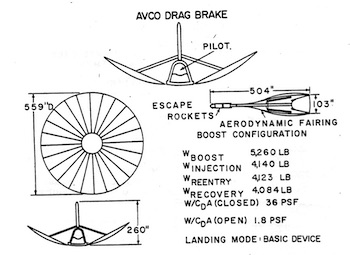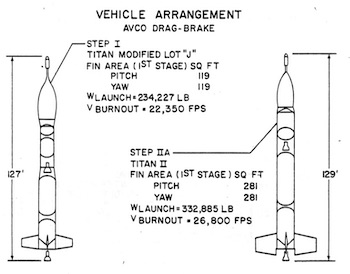
Home - Search - Browse - Alphabetic Index: 0- 1- 2- 3- 4- 5- 6- 7- 8- 9
A- B- C- D- E- F- G- H- I- J- K- L- M- N- O- P- Q- R- S- T- U- V- W- X- Y- Z
Avco Project 7969
 Project 7969 Avco Credit: NASA |
Status: Study 1958. Gross mass: 680 kg (1,490 lb). Height: 2.13 m (6.98 ft).
In March 1956 the Air Research and Development Command (ARDC) the Task 27544 Manned Ballistic Rocket Research System research project. In the absence of any funding from headquarters, ARDC had to rely on the contractors to invest their own funds in feasibility studies. Avco, the lead USAF contractor for ICBM re-entry vehicles, produced its first study by November 1956.
On 20 November 1957 Avco issued its second and more detailed study, "Minimum Manned Satellite." Avco's approach was a pure drag re-entry vehicle boosted into a 200-km orbit by an Atlas ICBM. The Avco spacecraft was a manned capsule that would re-enter the atmosphere on a stainless-steel-cloth drag brake. Shaped like a shuttlecock, the mechanism was supposed to brake the capsule through re-entry. Then air pressure would expand the parachute to a diameter of 11 m, braking the capsule to impact at 11 m/s. Avco would need $500,000 for a further three-month study and to construct a mock-up of the capsule. But the Air Force's Ballistic Missile Division was skeptical about the drag-brake idea, and the ARDC could commit no funding. Nevertheless the Avco began engineering coordination meetings with Convair on interfacing the capsule with the Atlas. Avco had a decided advantage since, as builder of the Atlas missile re-entry vehicle, it already had the necessary security clearances and technical details, whereas other contractor and NACA staff could not be briefed on the characteristics of the still highly-classified missile.
On 20 to 31 January 1958 ARDC held a secret conference at Dayton where eleven airframers briefed their concepts for the first American manned spacecraft. There seemed to be a consensus that the basic Atlas ICBM alone was incapable of boosting sufficient payload to orbit for a manned capsule. Therefore at that briefing Avco proposed that their spacecraft would be boosted by a Titan booster into a 190 km orbit for a one week mission. Despite the aerodynamic control system spacecraft control was automatic and no pilot inputs were required. Maximum G-forces during re-entry were 9 g's and the radiative heat shield was of molybdenum or Inconel. In case of booster failure during ascent to orbit the upper stage would catapult the capsule 1 km from the launch vehicle, followed by a parachute descent to earth. The spacecraft had a ballistic coefficient (m/CdA) of 7.3 kg per square meter. Landing precision was 'within Kansas' (650 x 300 km landing footprint). It was expected that a first manned orbital flight could be achieved 30 months after a go-ahead at a cost of $ 40 million.
On 10-12 March ARDC held a conference of 80 technical and biological specialists. The objective was to reach agreement on a plan to get a man-in-space - soonest - in accordance with General LeMay's orders. Unfortunately for Avco's design, the consensus at the conference was that the "quick and dirty" approach was best. This would consist of a simple ballistic capsule using parachutes for a water landing, weighing around 1,300 kg. Furthermore, nobody advocated using the Atlas alone as the booster. The medical specialists concluded that the occupant might be subjected to 20-G's in an abort from the Atlas, believed to be beyond the limit of human tolerance, whereas a two-stage vehicle would limit that to an acceptable 12-G's. Space Technology Laboratories, technical advisor to the Air Force for the ICBM program, believed the Atlas would be too unreliable. They favored using the Thor IRBM with the Nomad fluorine-hydrazine upper stage.
ARDC sent its crash development plan for a manned orbital capsule to Headquarters USAF on 14 March. Based on this, on 19 March, the Air Force requested $133 million from ARPA for the program in FY 1959. By 2 May the USAF's Man-In-Space task force forwarded to Headquarters USAF the detailed designs, operational procedures, and schedule for Man-in-Space-Soonest. The Thor-Agena/WS-117L, Thor-Able, and Thor-Nomad boosters would be used. The first manned flight would be made on the tenth launch of the Thor-Nomad, in October 1960.
But suddenly there was a three-week delay. Avco had gotten back together with Convair, and on 30 April they back-doored to LeMay a convincing and highly detailed proposal for development of their minimum vehicle. This used the Atlas without an upper stage, and the same Avco drag brake design that they had been working on for two years. Even the USAF's Ballistic Missile Division, which hated the idea of using the "bare" Atlas, had to admit it would save four months in development time. But ARDC, advised by Faget at NACA, still favored the simple ballistic capsule with a parachute landing. Therefore on 20 May, Lieutenant General Samuel E Anderson, Commander of ARDC, replied to LeMay that he had no confidence in Avco's design, and recommended that the Air Force proceed as per the 2 May plan. LeMay accepted the response, and the program lurched back into gear. It was the end of the road for Avco's innovative manned spacecraft design.
Technical Description
The modulated-drag-brake re-entry device achieved variable drag by means of a foldable umbrella-like structure surrounding the payload capsule. This re-entry device configuration was developed by the Everett Division of AVCO. This configuration enjoyed advantages in weight and simplicity.
The 2,385 kg spacecraft had no lift coefficient and could not make any cross-range maneuvers. During boost the drag brake was folded around the pilot and equipment compartment. The upper section of the vehicle consisted of abort rockets and fairings. After a successful first-stage boost, these items were jettisoned. During orbit the drag brake remained closed and vehicle attitude was controlled by reaction jets.
The drag brake was modulated to achieve re-entry at a preselected altitude, position, and velocity. At the re-entry point, defined by the magnitude of the deceleration, the drag brake was locked in the fully opened position. Modulation to a deceleration of 0.lg resulted in a longitudinal dispersion of +/- 240 km and a lateral dispersion of +/- 29 km from the preselected landing point. Modulation to a deceleration of 1.5g would reduce the longitudinal dispersion distances to +/- 29 km. Lateral-range control was not possible during re-entry.
The open drag brake served in lieu of a parachute for landing. An alighting gear in the form of 24 metal bellows was inflated to limit ground impact deceleration. Impact occurred at a velocity of 17 m/s.
Escape from the booster was accomplished by firing escape rockets mounted on the nose fairing assembly. When a safe altitude was reached, the fairing and rockets were jettisoned and the drag brake was opened for descent to the ground. Escape from orbit was accomplished by fully opening the drag brake.
The drag-brake device was designed for one re-entry trajectory. Although some altitude variation could be achieved by varying drag, the device was designed for complete deployment of the brake during re-entry.
 Avco Booster Alternatives Credit: NASA |
The maximum design temperatures were 930 deg C on the stagnation plate and 775 deg C on the side of the brake. The drag brake was a fold-able umbrella-like structure. The outside skin of the drag brake was composed of a flexible woven mesh of 0.0038-cm-diameter Rene 41 wire, 83 to the cm. A coating of glass frits, held in a silicone rubber base, was applied to the skin in order to achieve nonporosity. Twenty-four ribs, spaced at 15 deg intervals, supported the wire-mesh skin. These ribs consisted of two side-by-side trusses which were joined at the top by common chord members and separated at the bottom to form an included angle of approximately 29 deg . Cross-members between the bottom chords completed the truss assembly. The truss members were tubular and fabricated from Udimet 500 (a nickel-chromium-cobalt alloy that was age-hardenable for high temperature strength). The actuator struts reacted the major portion of the rib loading and were essentially compression members. They also served to position the ribs during drag modulation through their attachment to the actuator mechanism. These struts were circular in cross section with essentially a frame-stringer type of construction. The material used was Udimet 500.
The pressurized body structure contained a 2.1-cubic-meter pilot's compartment pressurized to 0.68 bar and a 2.8-cubic-meter equipment section pressurized to 0.41 bar. These two compartments were integrally attached by seam welding to a main structural cone. This structural cone carried the compartment inertial loads and the reaction loads of the drag brake, the actuator, and the booster transition section. A 2.6-m-diameter stagnation plate, covered with Teflon, formed the bottom of the body structure. The entire body was covered with a 5-cm layer of Thermoflex insulation. Entrance to the pilot's compartment was provided by a 51-cm-diameter hatch located on the compartment side wall. Access to the equipment compartment was provided by a 1.22-m-diameter hatch located in the center of the compartment floor.
A summary weight statement for the drag-brake device is as follows for a one-orbit mission:
- Re-entry vehicle (boost) at launch: 2,385 kg
- Re-entry vehicle at second-stage jettison: 1,878 kg
- Airframe: 811 kg
- Landing gear: 91 kg
- Secondary power: 94 kg
- Flight controls: 40 kg
- Electronics: 135 kg
- Environmental control: 94 kg
- Crew operations: 158 kg
- Payload: 454 kg
- Re-entry vehicle (re-entry): 1,870 kg
- Re-entry vehicle (landing): 1,852 kg
Family: Manned spacecraft. Country: USA. Launch Vehicles: Titan, Titan I. Agency: USAF, Avco. Bibliography: 26, 483, 59.
Back to top of page
Home - Search - Browse - Alphabetic Index: 0- 1- 2- 3- 4- 5- 6- 7- 8- 9
A- B- C- D- E- F- G- H- I- J- K- L- M- N- O- P- Q- R- S- T- U- V- W- X- Y- Z
© 1997-2019 Mark Wade - Contact
© / Conditions for Use